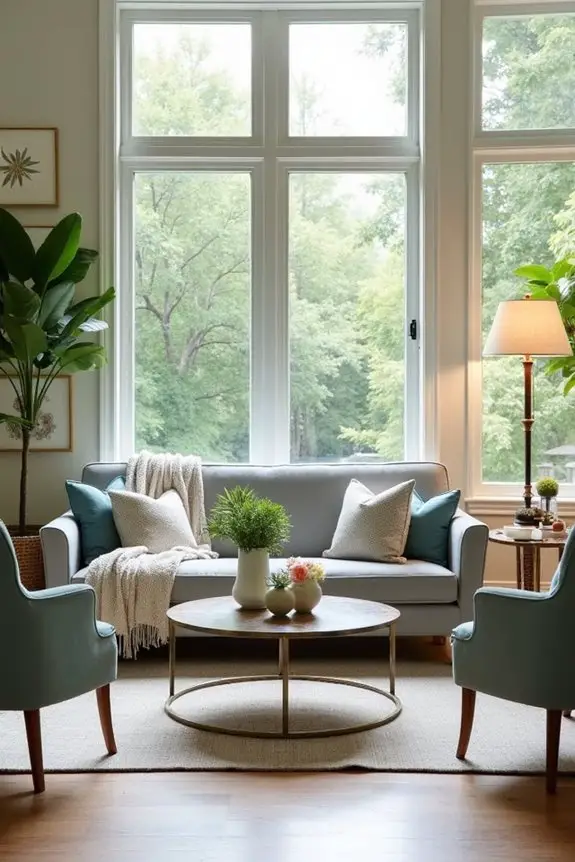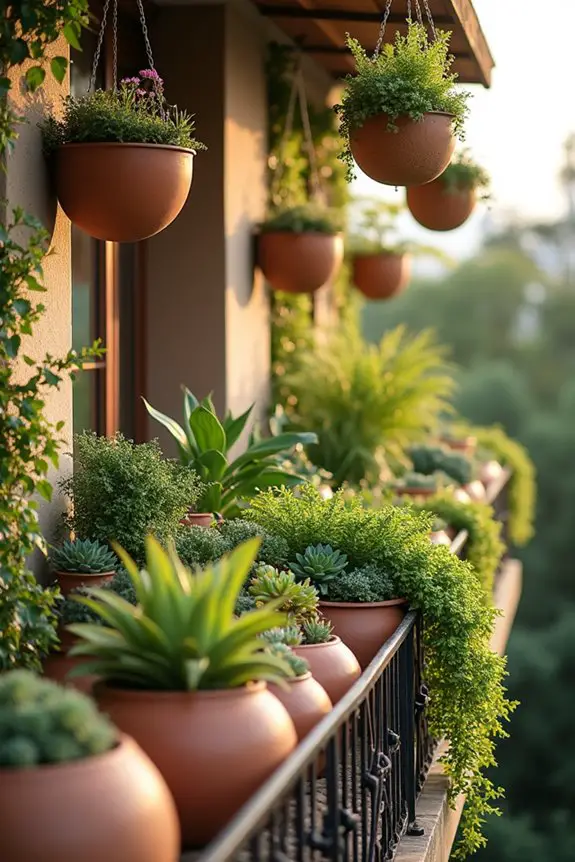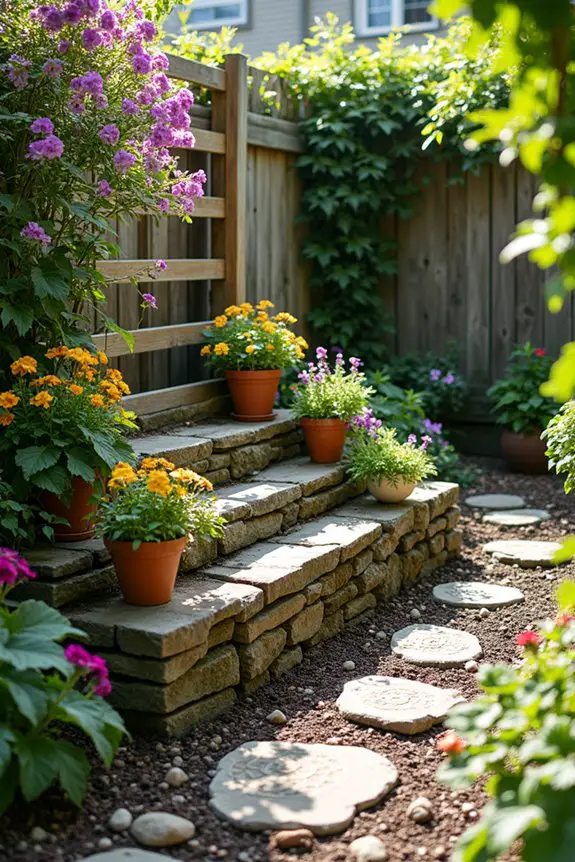Did you know that the average person spends about 93% of their life indoors? Crazy, right? With that in mind, transforming your garden room into a cozy retreat can make a world of difference. Imagine curling up in a nook with your favorite book or practicing yoga as sunlight pours in. Sounds inviting, doesn’t it? Well, stick around for a handful of design ideas that’ll turn your space into the perfect escape.
Inspirational Garden Room Concepts
When it comes to creating your garden room, there are so many cool concepts to contemplate.
Think about an open-plan seating arrangement that makes you feel relaxed, or zoned spaces that can transform from a reading nook to a casual hangout spot.
And let’s not forget about multi-functional furniture—who doesn’t love a table that can double as a game night haven?
1. Open-Plan Seating Arrangement

When it comes to creating a dream garden room, an open-plan seating arrangement is a brilliant choice. Not only does it make the space feel larger and more inviting, but it also encourages effortless mingling and relaxation—a must for hosting friends or just enjoying a cozy afternoon with a good book. Envision sinking into a cushy chair with the garden’s colors swirling around you, as nature whispers its calming presence. Sounds lovely, right?
Let’s break down how to craft this inviting vibe. Start by choosing multifunctional furniture pieces. Think a spacious sofa that can double as a guest bed or a chic coffee table that tucks away to create more floor space. You could even choose a sectional that wraps around the room, creating a comfy nook where everyone feels included. And don’t forget those eye-catching poufs that can be easily moved around for extra seating when your friends stop by—or when your cat decides it’s time to take over. Incorporating a garden outdoor storage bench can also be a stylish way to keep blankets and cushions handy for cooler evenings.
Next, think about the layout. Visualize your seating arranged in a circle or an inviting U-shape, making it easy to chat and laugh without straining your neck like a tortoise trying to peer across the room. It allows everyone to connect, whether you’re sipping morning coffee or having a nightcap while counting the stars above.
Lighting can make or break your garden sanctuary, so opt for a mix of ambient and task lighting. String fairy lights across the ceiling or hang a whimsical pendant light for that fairy-tale touch. You want the space to feel warm and friendly, like your favorite cozy café, but with fewer hipsters juggling lattes. Consider incorporating a potting bench with storage to keep your gardening essentials organized while enhancing the beauty of your room.
Finally, add those personal touches that scream *you*. Maybe it’s a collection of cute cushions in patterns that reflect your personality or a vibrant rug that ties everything together—no, not like that one rug you tripped over last summer. Surround yourself with plants too; they not only purify the air but add a lush, vibrant feel to the whole space. Just think of all the compliments you’ll get, “Wow, your garden room is like a tropical paradise!” You’ll shine bright with pride.
Crafting this open-plan seating arrangement lets your garden room be both functional and a true reflection of you. It invites connections, laughter, and moments that linger long after your guests leave. So go ahead, start planning your perfect cozy corner; you’ll love how it transforms your space into a dream garden getaway.
2. Zoned Spaces for Activities
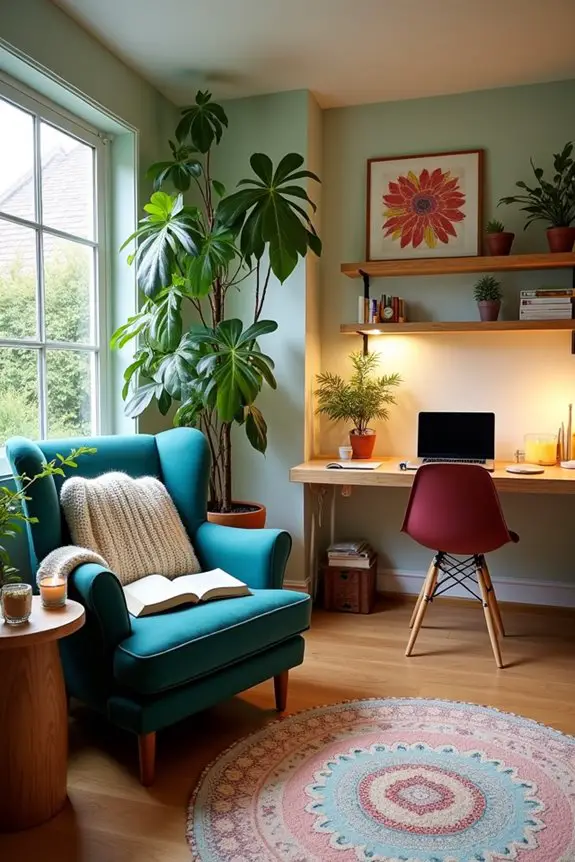
Creating designated zones in your garden room can elevate both its aesthetics and functionality, making it the perfect retreat for various activities. Envision this: a cozy nook for reading, a vibrant spot for yoga, and maybe even a small workspace where creative ideas can flourish. By carving out these specialized areas, you not only make better use of the space, but also invoke a delightful sense of harmony.
It’s like having a tiny coffee shop, a peaceful meditation corner, and a mini studio all under one roof—who wouldn’t want that?
When you initiate zoning your garden room, start with what activities you enjoy most. Do you love curling up with a book? Create a reading corner with a plush chair, a soft throw blanket, and a small bookshelf nearby—just don’t let it turn into a “to-be-read” mountain that rivals Everest.
Keep a small side table for your drink of choice; nothing beats a steaming cup of tea while you explore a new world. Prefer to strike a pose? Lay down a yoga mat in a sunlit area, add soothing plants for that tranquil vibe, and perhaps a calming candle (which, if you’re like me, you’ll burn it too close to the mat and have a mini freak-out moment). Consider incorporating a wireless weather station to monitor the conditions outside, ensuring your garden room feels just right.
Next, think about furniture placement that subtly distinguishes these zones. Use rugs to define spaces. A soft, fluffy rug can say, “Welcome to the cozy corner,” while a lighter, airy mat can signal the yoga area.
And speaking of furniture, remember to keep it simple and adaptable. Try a folding screen to demarcate a workspace; just remember to keep the clutter at bay unless you want to start an epic search for your missing pen.
Lighting plays a huge role in each zone as well. Bright task lighting over your workspace will help you conquer your to-do list, while soft ambient lighting in the reading nook will cast a warm glow, perfect for evening escapades into fiction.
And don’t forget the plants—because they’re like the sprinkles on the cupcake of a well-designed garden room. They liven up any spot, especially if you choose varieties that thrive in light and serve as natural air purifiers. Additionally, incorporating artificial garden hedges can provide a stylish and low-maintenance way to enhance the overall ambiance of your garden room.
Don’t be afraid to inject your personality into this design, too. Maybe hang up quirky art pieces that inspire your creativity or display mementos from memorable trips. Incorporate fun textiles that reflect your style, whether it’s boho-chic or sleek and modern.
Creating zoned spaces for various activities isn’t just about practical organization; it’s about nurturing your passions and finding balance. You’ll love how this arrangement fosters a sense of peace and purpose in your garden room, making it a sanctuary for whatever your heart desires—be it reading, yoga, or just sipping coffee while contemplating the mysteries of the universe.
3. Multi-Functional Furniture Arrangement

When it comes to creating a magical garden room, multi-functional furniture is your best friend. Imagine this: a coffee table that effortlessly transforms into a workspace for those bright ideas, a cozy ottoman that doubles as storage for blankets, or a daybed perfect for both lounging and occasional overnight guests. Not only does this setup save space, but it also invites creativity and adaptability into your life. Plus, you get that warm, homey vibe that wraps around you like a soft hug.
Let’s start with the golden rule of multi-functional design: prioritize versatility. For instance, consider a sleek sofa bed. Not only does it provide a comfortable seating area for those relaxed afternoons, but it also transforms into a bed for friends and family who might, you know, just drop by unexpectedly (thanks, Aunt Cathy). Remember that the sofa bed can work wonders as a design centerpiece too! Dress it up with colorful cushions and a throw; it’ll look so fab that no one will ever guess it’s a two-in-one.
Now, how about a coffee table that has hidden compartments? These clever pieces not only hold your snacks while you binge-watch your favorite show (guilty as charged) but can also keep your board games stashed away or even accommodate a few books for when the mood strikes. Just imagine plopping your feet up after a long day and easing your worries away with your favorite puzzle or a riveting story, all within arm’s reach.
Next, let’s talk about the power of nesting tables. These delightful little wonders can be placed together for family game night or spread apart for different activities. They can serve as drink stations, side tables, or even makeshift desks if a sudden spurt of inspiration hits you (always when you least expect it, isn’t it?). Their compact design allows for easy moves, and they come in so many fun styles that they can fit into any theme—be it rustic chic or modern minimalist.
Don’t forget about a versatile storage bench. It’s perfect for stashing away yoga mats, craft supplies, or those shameful half-finished projects. Plus, it provides extra seating if you’re hosting a cozy get-together with friends (you know, the one where the snacks mysteriously disappear and the laughter fills the air).
Finally, let’s not be shy about adding some layers. Throw a lovely blanket or tray on top of your furniture to give it a personal touch while enhancing the room’s functionality. A bit of texture can bring warmth to your space and paint a picture of comfort that welcomes anyone to kick back and stay awhile. Furthermore, a wooden garden table set can seamlessly blend functionality and elegance into your outdoor area, providing an ideal space for alfresco dining or relaxation.
Incorporating multi-functional furniture not only maximizes your garden room’s potential but gives it character. It’s like throwing a party where every piece has its own interesting story to tell, while still being there for you when you need it most. So, go ahead—mix things up, and watch your garden room transform into a haven of creativity and comfort.
4. Asymmetrical Plant Arrangement
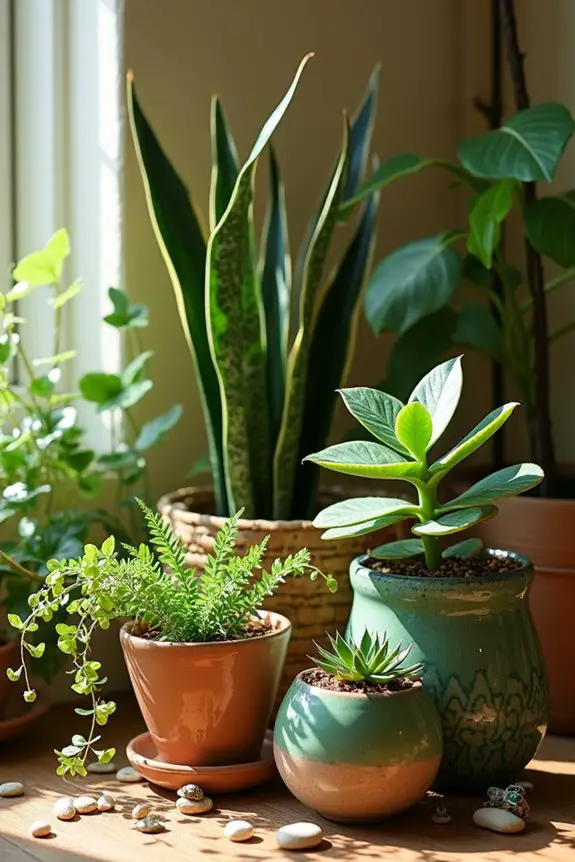
When it comes to curating a dreamy garden room, an asymmetrical plant arrangement can really take your space to the next level. This approach not only adds a touch of whimsy and creativity to your decor, but it also promotes a relaxed and inviting atmosphere.
Envision this: a riot of colors and textures nestled together just feels like a secret garden waiting to be discovered. It’s all about embracing the unexpected and letting your plants create an organic flow that stands out beautifully.
To start your asymmetrical arrangement, grab a selection of plants in varying heights and shapes. Imagine this: a tall snake plant paired with a trailing pothos that cascades down from a shelf. It’s like planting nature’s own artwork right in your room. You don’t have to go overboard—sometimes less is more. Select between three to five plants that speak to your heart. But hey, if you get a little carried away, that’s okay too. We’ve all been there, right? Just try to avoid turning your space into a mini jungle that could house an entire family of monkeys.
Next, think about the placement. Instead of lining them up like soldiers, place them at varying distances and angles. Let’s say you position the taller plants at the back or on a higher shelf to create depth. Then sprinkle in medium-sized beauties towards the front.
A small hint here—if you have a quirky, low table, try placing a cluster of smaller pots on it for an artistic vibe. You want to draw the eye around the space, creating little surprises wherever it lands.
Now, the pots themselves can add to the charm. Opt for various shapes and materials like rustic terracotta, glossy ceramics, or even colorful woven baskets to spice things up. This variety won’t only make your arrangement pop but also create a delightful contrast. The key is to go for a cohesive color palette.
Maybe you stick with greens and neutrals, or dare to mix in some bright hues. Just remember, plants and pots can mirror your personality, so choose what feels right for you.
Finally, don’t forget to layer in some accessories. Maybe a few stones around the base of your plants or a whimsical figurine tucked in there somewhere. It’s those little details that breathe life into your garden room.
And hey, if you accidentally knock over a plant while trying to rearrange, just know you’re not alone—I’ve done it too, and no, my cat didn’t help clean up.
With all these tips in hand, you’re ready to create an asymmetrical plant arrangement that transforms your garden room into a vibrant haven. So, roll up your sleeves, get a little dirty, and plant your way to bliss. After all, it’s all about enjoying the journey—messy bits and all.
5. Circular Pathway Design
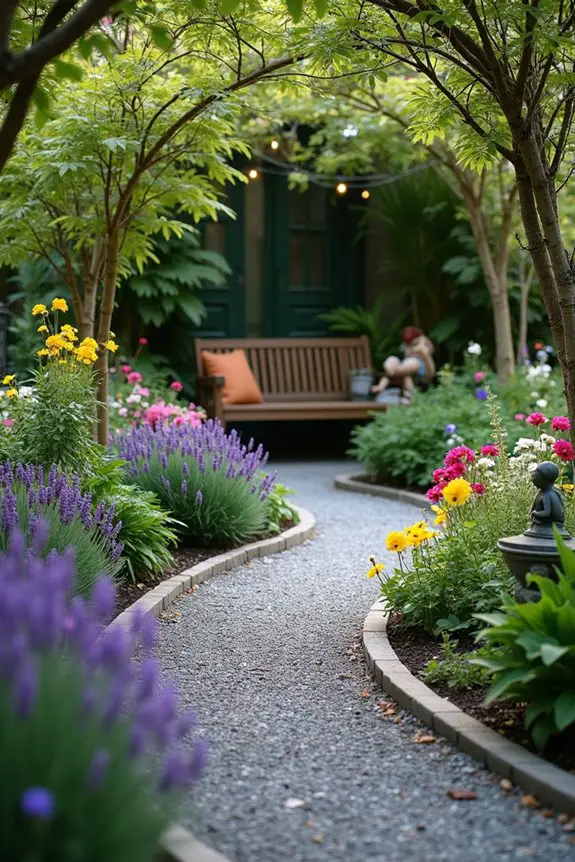
Creating a circular pathway in your garden room isn’t just a practical design choice; it’s a transformative experience that invites movement and flow. Envision this: a winding path that guides your guests through lush greenery while providing a serene escape from the chaos of everyday life. A circular design encourages exploration and creates a cozy, intimate atmosphere, making it feel like you’ve tucked away a little enchanted haven right in your home.
To get started on your circular pathway, you’ll want to map out your space. Grab a roll of garden hose or string—yes, I know it sounds a bit quirky, but it works wonders. Lay it out in a circular shape, adjusting as necessary until you’ve found the perfect flow. Trust me, trying different sizes will help you figure out what feels just right for your room. You want it to feel inviting, not like you’re carving out a racetrack. And hey, if you find yourself cracking up as you attempt to mold the hose into a perfect circle, you mightn’t be the only one resembling a confused giraffe.
Next comes the fun part: choosing your materials. Think about gravel, stepping stones, or even wood slices. If you’re feeling crafty, you could gather some leftover tiles from that project you’ve been putting off since last summer. You can arrange them on your circular line to create a sturdy path. Just an important tip: make sure whatever you choose is comfortable underfoot. After all, the last thing you want is a guest teetering awkwardly like a tightrope walker.
Now, let’s talk about the plants flanking your pathway. Choose plants that thrive in your space’s lighting conditions, mixing heights and colors to create visual interest. Think about using fragrant herbs like lavender or mint along the edges—imagine the calming aroma wafting through the air as you stroll by. And if you’re anything like me, half the fun of gardening is discovering they actually grow because, believe me, I’ve had my share of “oops, that one didn’t make it” moments.
To add some whimsy, consider placing lanterns or whimsical garden statues along the pathway. A quirky frog peeking out from behind a bush or some fairy lights strung overhead can create a magical feel as twilight settles in. Suddenly, your garden room isn’t just a room; it’s an adventure waiting to happen. I remember the time I added a gnome with a slightly mischievous grin and let’s just say, he’s been a conversation starter at every gathering since.
Finally, don’t forget to keep your pathway well-maintained. Regularly reset loose stones, and trim errant foliage that might encroach on your walking area—no one wants to feel like they’re hiking through a jungle when they’re just trying to check out the latest plant addition. A little bit of upkeep goes a long way in keeping the charm alive.
With your circular pathway set up, you’ll find yourself wandering through your garden room with a smile, embracing the peaceful vibe and the inviting atmosphere it brings. Grab a cup of tea, take a stroll, and enjoy the beautiful chaos that’s your own creation!
6. Modular Sectional Configuration
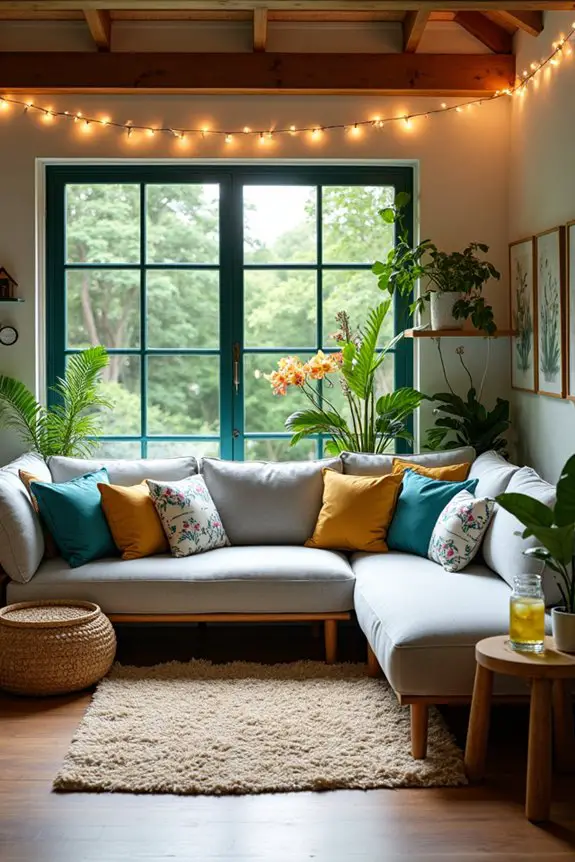
When it comes to designing your dream garden room, a modular sectional configuration can be a game-changer. This flexible setup not only enhances functionality by maximizing seating options, but it also creates an inviting atmosphere for both relaxing and entertaining. Imagine a cozy nook where you can unwind with a book or gather with friends over a glass of lemonade. Sounds heavenly, right?
First, let’s talk about choosing the right modular sectional. Look for pieces that can be rearranged easily according to your needs. There are so many styles out there, from sleek modern designs to more rustic, cushy options that just scream for a cup of tea. Consider colors and materials that blend with your garden theme. Maybe a vibrant pop of color to brighten up the space or neutral tones that harmonize with the lush greenery outside? Your choice here is essential; after all, you don’t want your sectional clashing with the lovely flowers, unless you’re going for that bold, “look at me” spark.
Once you’ve got your sectional selected, think about the arrangement. Positioning is everything. You might want to create a semi-circle that invites conversation, much like how I inadvertently create awkward eye contact at family gatherings, trying to figure out who gets to speak first.
Or perhaps you’d prefer a cozy L-shape for movie nights under the stars—I once found myself binge-watching an entire season of a series on a sectional late into the night, surrounded by fairy lights and warm blankets. Best night ever.
Incorporate soft cushions and throws to amp up comfort. Plush pillows can transform your sectional from just a seat to a true sanctuary; it’s like having a sugary dessert after a healthy meal. You can also mix and match different patterns. Don’t be afraid to experiment—just maybe not all at once.
I once decorated my space with every whimsical print I could find, and let’s just say it looked less like a garden paradise and more like a circus.
And let’s not forget the importance of accessibility! Consider keeping a small side table within reach for drinks and snacks or even a cute little garden cart to hold refreshments.
This way, when the sun is shining and you’re lounging in your garden room, you can reach for that chilled lemonade without making an Olympic effort. Trust me, nothing kills the garden vibe like having to get up multiple times to grab refreshments—before you know it, you’ll be tired just thinking about it.
Lastly, add some personal touches to really make the space your own. Maybe hang up a few of your favorite garden-themed artworks, or scatter some potted plants around the room to infuse life and color.
I love how just adding a few blooms can turn a simple sectional into a lively retreat! This garden room will be a reflection of who you are, a space where comfort reigns supreme and every gathering feels special.
7. Vertical Garden Wall Integration
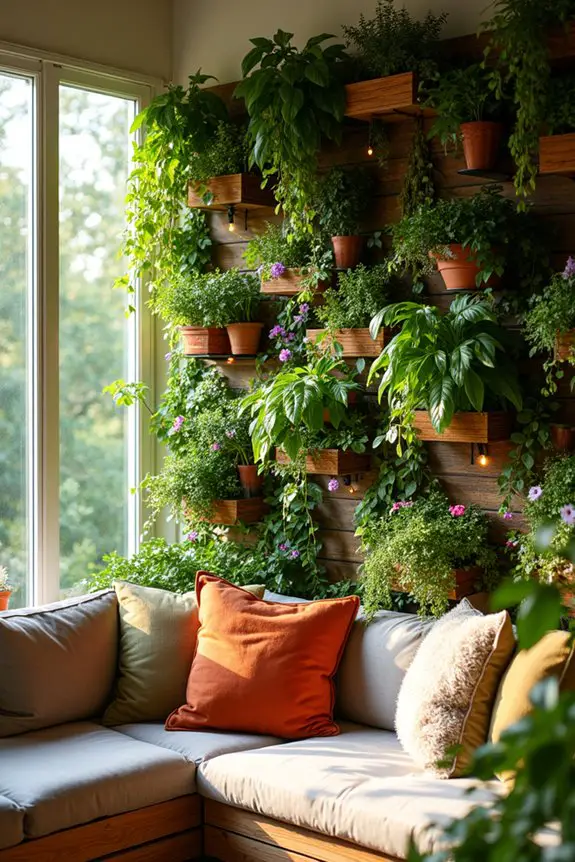
When you think about adding some flair to your garden room, a vertical garden wall can really turn heads. Not only does it bring a burst of life to the space, but it can also save on floor space.
Imagine this: a lush wall covered in greenery, where trailing vines and bright flowers dance in the breeze, creating a peaceful vibe that makes you feel like you’re living in a cozy forest nook. How can you resist that calming atmosphere?
To get started, pick the right wall. This could be an exterior wall of your garden room or even a sturdy partition inside. Make sure it gets enough sunlight or consider adding some grow lights if you’re working with a shadier spot. The last thing you want is to invest time and effort into a garden wall that ends up looking as sad as that wilty houseplant I tried to bring back to life last summer.
Next, think about which plants you’d like to incorporate. Herbs like basil and mint can add an aromatic twist to your garden room while being handy for your culinary experiments. Floral options like trailing petunias or climbing sweet peas can create visual interest.
You know what’s magical? The feeling of plucking fresh mint for a drink right from your vertical garden wall. Just be cautious not to overcrowd your wall, or it might end up looking more like a jungle than an elegant garden.
Once you’ve chosen your plant companions, you’ll need to create a support system for them. You can find pre-made vertical garden kits at your local garden store or build your own with some wooden pallets and pockets for plants.
Just be careful when assembling—trust me, nothing screams amateur like a half-leaning, wonky garden wall. I once attempted to DIY a vertical garden and let’s just say, a little too much enthusiasm led to a mini collapse.
Now that the wall is set, consider the watering system. If you’re more of a water-forgetter than a water-rememberer, you might want to explore a drip irrigation system. They make it much easier by delivering just the right amount of moisture without turning your space into an indoor swamp—don’t want that.
I learned the hard way that overwatering can quickly turn a promising plant project into a scene from a horror movie with moldy mysteries lurking.
Finally, accessorize your vertical garden wall with some charming elements. Hanging fairy lights can add a magical touch in the evenings. A few decorative pots or even small art pieces can personalize it and make it truly your own.
Just don’t go overboard, or it might look more cluttered than cozy—definitely learned that lesson after trying to hang a mini wind chime, garden gnome, and a colorful flag all in one go. Let’s just say I know now that less can be more.
With a vertical garden wall, you’re not just adding a design element; you’re creating a calming escape and a beautiful focal point.
8. Cozy Nook Corner Setup
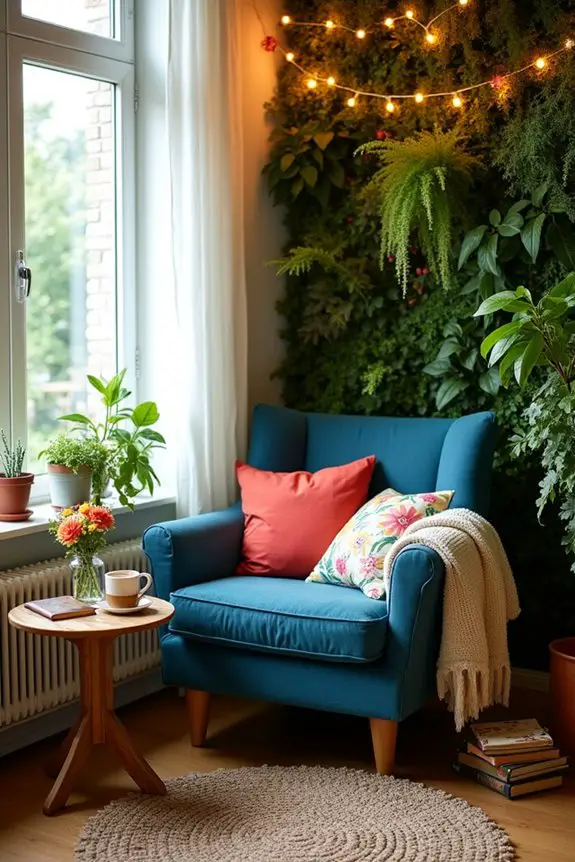
Creating a cozy nook corner in your garden room can transform it into a peaceful retreat that invites you to unwind, read a book, or sip your favorite tea. Not only does it add functionality to the space, but it also infuses personality and warmth, making your garden room feel like a slice of paradise at home.
Think comfy cushions, soft throws, and maybe even a good view of your vertical garden wall—why wouldn’t you want to settle in right there?
To kick things off, choose a corner of your garden room that feels natural and inviting. You could position it near a window for maximum natural light or right next to your vertical garden wall for a lush backdrop.
If you have the luxury of space, a small bistro table could be just the ticket for a peaceful breakfast nook. Trust me, enjoying your morning coffee surrounded by greenery feels downright magical. Picture it—your cozy corner bathed in soft sunlight, with the scent of freshly brewed coffee mingling with the earthy notes from your plants.
Next, think about the seating. A plush armchair or a small loveseat can create a snuggly spot for you to curl up. If you’re feeling crafty, you might even consider upcycling an old chair with some paint and fun cushions.
I once painted an old chair a cheerful yellow, hoping it would inspire sunny vibes, and you know what? It totally worked. It was like inviting the sun to sit down for a chat every time I plopped in it.
Now, let’s talk cushions. You can never have too many of these. Opt for different shapes and sizes to mix things up, and feel free to experiment with patterns. Don’t be afraid to embrace bold colors—a bright red paired with a rich green can really pop in a garden room setting.
Just like your grandma’s patchwork quilt, a mix of textures and styles brings depth, comfort, and a hint of nostalgia to your cozy nook.
Lighting is another essential aspect. For that inviting glow come evening time, think about incorporating warm, ambient lighting. String fairy lights across the wall, or use a small table lamp with a soft hue.
I once tried using a bright white bulb, and let’s just say it felt more like I was in a lab than a cozy corner. Soft light creates a warm atmosphere that invites relaxation instead of a glaring sunburn.
Lastly, consider personal touches that make the space uniquely yours. Maybe a stack of your favorite books or photographs that evoke happy memories. Or a small plant friend to keep you company—because who doesn’t want to chat with a fern named Fernie?
These little details add character to your nook and feed your soul whenever you settle down to enjoy the space.
Creating a cozy nook corner isn’t just about aesthetics; it’s about crafting a little oasis where you can breathe, reflect, and simply be. So, grab that cup of tea, settle into your comfy chair, and indulge in your beautiful garden room retreat, a world away from the bustle outside.
9. Natural Light Emphasis
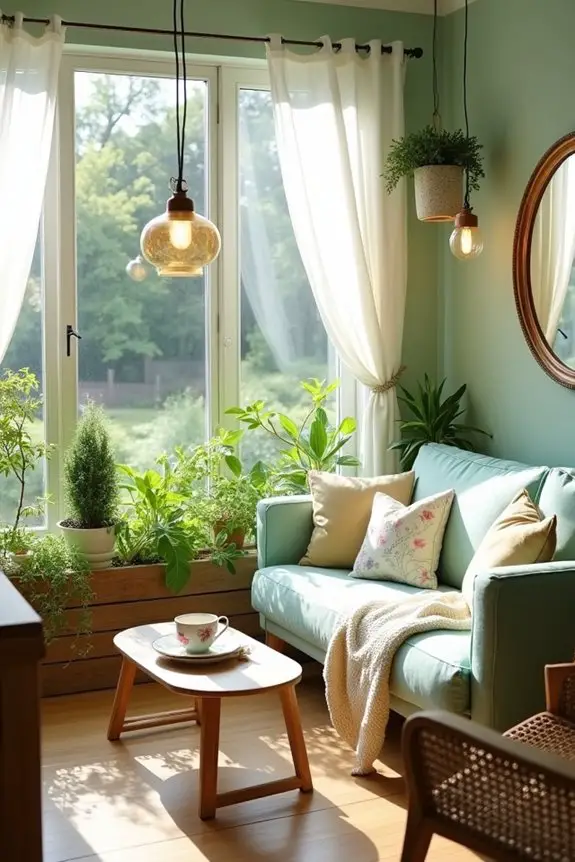
When it comes to designing your garden room, one of the best strategies is to emphasize natural light. Not only does it create a bright and airy atmosphere, but it also helps your plants thrive and makes the space feel open and welcoming.
Think of your garden room as a sun-drenched haven where you can truly breathe and relax.
To start, take note of your room’s layout and how the light moves throughout the day. If you have big windows, fantastic! If not, don’t fret—there are still plenty of ways to maximize the light. Consider using sheer curtains or blinds that can be pulled back easily during the day.
I once installed some lovely sheer white drapes and, let me tell you, it was like inviting the sunshine to a dance party. The light just poured in, and it instantly made the room feel more lively.
Next up, reflect that beautiful natural light. You can do this by incorporating mirrors into your design. A strategically placed mirror can amplify the sunshine, making the space feel even larger and more open.
You don’t have to splurge on sleek, modern ones either; vintage mirrors can add character and a touch of whimsy. There was a time I found a funky, round mirror at a thrift store; it looked like something from the ’70s, but I adored how it bounced light around.
It’s like having a little disco ball—who wouldn’t want that?
Also, consider your furniture choices. Opt for lighter colors that can reflect light rather than absorb it. Soft pastels or bright whites can really enliven the space.
I remember rolling the dice on a soft mint green sofa, and it turned out to be the perfect choice. It made the garden room feel bright and fresh, like Summer Day, without the sticky heat.
Just be sure to steer clear of dark woods or bold colors that might swallow the light instead of embracing it.
Don’t overlook the importance of plants, either. Go for greenery that enjoys bright light—think succulents, herbs, or even a small citrus tree if you’re feeling ambitious!
It’s like the cherry on top. The way they soak up that sunlight isn’t only good for the plants but enhances the whole vibe of your garden room. Plus, the burst of color from the leaves adds vibrancy and life.
Lighting fixtures can be game-changers too. While you want natural light to shine during the day, think about warm-toned lamps or pendant lights that can mimic that vibe as night falls.
Dimming lights or adjustable lamps can create that cozy, evening atmosphere. I made the mistake once of thinking I needed a bright lamp to combat the evening darkness, but it felt like I was camping in a gas station instead of enjoying the comfort of my garden room at night.
Soft light is key.
Incorporating natural light into your design ultimately creates a serene, inviting space where you can unwind or indulge in your passions.
It’s about connecting with nature, inside and out. Embrace those sunny days and bring that joyful outdoor atmosphere into your little retreat.
10. Symmetrical Furniture Placement

When creating a garden room, one design approach that truly shines is symmetrical furniture placement. This technique not only enhances the room’s functionality, making movement and flow feel effortless, but it also fosters a sense of tranquility and balance. Think about it: there’s something inherently calming about seeing everything mirrored or balanced out, like when you walk into a perfectly set dining table. It just feels right, doesn’t it?
To get started with symmetrical furniture placement, assess the space you have. Picture a line running down the center of your garden room, and then envision your furniture being evenly distributed on either side of that line. For example, if you have a lovely couch along one wall, consider flanking it with matching armchairs or sleek side tables on each side. Instant charm. Just imagine walking into your garden room and being greeted by that cohesive look where everything aligns in perfect harmony—it’s almost like a visual hug.
A fantastic real-life example of this would be my own garden room. I’d this adorable loveseat I couldn’t resist, and I wanted to pair it with some fun accent chairs. Rather than just plopping them down haphazardly, I arranged them so that one chair was on each side of the loveseat, and I topped it all off with a colorful, matching throw blanket draped over the back of the couch. It felt so cozy and put-together, like I’d just entered my very own Pinterest board.
Try to think beyond just your main seating options. Consider using side tables, plants, or even artwork in a symmetrical layout. If you have a window on one side, a tall plant or a decorative lamp on the opposite side can create that lovely balance. For instance, I once placed a sturdy fern in a chic pot next to the window and mirrored it with a vintage lamp on the other side. It was like they were having a friendly conversation across the room—perfect harmony again.
Don’t forget about the impact of colors and textures. Even while maintaining symmetry, you can mix things up a bit. If your armchairs have a bold pattern, balance them out with a solid, neutral-colored couch. I once made the hilarious mistake of pairing two bright, floral chairs with a striped sofa, and let’s just say my garden room had all the vibes of a circus tent. So remember, you want to create a delightful visual balance, not a confusion of chaos.
Lastly, have fun with accessories! Throw pillows, rugs, and artwork can all contribute to achieving that stylish symmetry you’re after. If you make a trip to the store and find a set of two beautiful vases, get them both and place them on either side of your coffee table. Talk about making a statement! It’s like saying, “Hey world, I’ve got this thing on lock.”
In short, creating a symmetrical look in your garden room will work wonders. It makes your space inviting, functional, and utterly peaceful. Who wouldn’t want that? So grab your furniture, start arranging, and watch your garden room transform into a beautifully balanced retreat.
Efficient Storage Solutions
While it might seem intimidating to squeeze more storage into that cozy dream garden room, you’ve got plenty of clever options at your fingertips.
Think about vertical space—shelves mounted high can store everything from plants to tools, leaving floor space clear. You could also use stylish storage benches; they double as seating and hide mess.
Maximize your garden room’s potential with high shelves and stylish storage benches that blend beauty and function!
Got a wall? Hang some pegboards for an artsy touch and functional storage, too. And don’t forget about those under-bed bins; they’re perfect for keeping less-used items out of sight.
Explore garden room ideas like incorporating a vintage trunk or colorful baskets.
Seriously, who knew storing could be this fun? With creativity, you’ll have a beautiful room and everything in its place—how rewarding is that?

